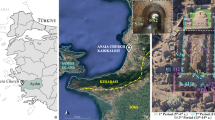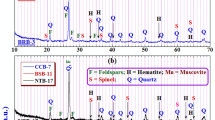Abstract
Fired bricks were for millenniums one of the main building materials of masonry structures of the old civilizations developed around Mediterranean basin. In ancient Greece, fired bricks systematically appeared in buildings from the fourth century bc, although ceramic manufacturing was well known since the pre-historic period. In this research study, the morphological, mechanical and physical characteristics, as well as the microstructure of old bricks from Greek monuments dated from the Roman and Byzantine period, are presented. Based on the results, bricks were usually produced manually by using empirical criteria. The bricks of Roman and Byzantine period were mainly plates of 30 × 30 or 30 × 40 cm. Their thicknesses ranged from 2.5 to 6 cm. Different additives were used to improve their properties, such as fine and coarse aggregates or fibrous materials. Generally, old bricks of those periods were of low apparent specific density (1.5–1.8), high absorption (13–30 %) and relatively low compressive strength (5–20 MPa), due to large pores and cracks into their matrix. Due to their surface roughness, the adhesion with the lime mortars was relatively high. A chemical reaction of lime mortar with the amorphous siliceous materials presented in old bricks has often contributed to the improvement of the mortar–brick bond. Since the characteristics and behavior of old bricks of the aforementioned historic periods do not differ much, it implies that both raw materials and the manufacturing techniques used for bricks production had not changed through a long historic period.













Similar content being viewed by others
References
Adam J-P (1994) Roman Buildings Materials and Techniques. (trans: Mathews A). B. T. Batsford Ltd, London, pp 58–64
Baronio G, Binda L (1997) Study of the pozzolanicity of some bricks and clays. Constr Build Mater 11(1):41–46
Böke H, Akkurt S, İpekoğlu B (2004) Investigation of the pozzolanic properties of bricks used in Horasan mortars and plasters in historic buildings. Key Eng Mater 264–268:2399–2402
Bouras Ch (1991) Lessons of history of architecture, vol I. Symmetria, Athens, pp 86–95 (in Greek)
Cook D, Ledbetter S, Ring S, Wentzel F (2000) Masonry crack damage: its origins, diagnosis, philosophy and a basis for repair. In: Proceedings of the Institution of Civil Engineers: structures and buildings, vol 140, pp 39–50
Davey N (1961) A history of building materials, chap 3. Phoenix House, London, pp 19–25
Fernandes F, Lourenco PB (2007) Evaluation of the compressive strength of ancient clay bricks using microdrilling. J Mater Civ Eng 19(9):791–800
Franke L, Schumann I (2009) Subsequent determination of the firing temperature of historic bricks. In: Baer NS, Fitz S, Livingston RA (eds) Conservation of historic brick structures. Donhead, Dorset, pp 17–23
Fratini F, Ceccherini S, Degl’Innocenti N, Malesani P (1993) Bricks: composition and physical characteristics as a function of the raw materials. In: Thiel M-J (ed) Conservation of stone and other materials, vol 1. RILEM, Paris, pp 228–237
Larsen E-S, Nielsen C-B (1990) Decay of bricks due to salts. Mater Struct 23:16–25
Lourenco PB, Fernandes FM, Castro F (2010) Handmade clay bricks: chemical, physical and mechanical properties. Int J Archit Herit 4(1):38–58
Moropoulou A, Bakolas A, Bisbikou K (2000) Physico-chemical adhesion and cohesion bonds in joint mortars imparting durability to the historic structures. Constr Build Mater 14:35–46
Morton J, Richardson B, de Vekey RC (1990) Deterioration of materials. In: Sowden AM (ed) The maintenance of brick and stone masonry structures. E & F SPON, New York, pp 117–139
Neville AM (2000) Properties of concrete. Pearson Education Asia Pte. Ltd, London, pp 412–474
Orlandos A (1958) The building materials and architectural techniques of the ancient Greeks, as evidenced by the authors, the inscriptions and the monuments, vol 2. The Archaeological Society, Athens, pp 83–116
Ousterhout R (2008) Master builders of Byzantium, University of Pennsylvania Museum of Archaeology and Anthropology, pp 128–132
Papayianni I (1997) A holistic way of studying mortars and bricks of ancient masonries for manufacturing compatible repair mortars. In: Proceedings of the fourth international symposium on the conservation of monuments in the Mediterranean, Rhodes 6–11 May. Technical Chamber of Greece, Athen, pp 265–274
Papayianni I (1998) Criteria and methodology for manufacturing compatible repair mortars and bricks. In: Biskotin G et al (ed) Proceedings of international conference, compatible materials for the protection of European cultural heritage, December, Athens, pp 179–190
Papayianni I, Stefanidou M (1995) Characteristics of bricks of old masonries. In: Papayianni I, Astrinidou P (eds) Workshop on materials for consolidation and restoration of monuments and historical buildings: reading, interpreting and recovering the knowledge of traditional materials, September, Thessaloniki, pp 35–48
Papayianni I, Stefanidou M (2000) Technology and characteristics of industrial bricks of 18th–19th century. In: Greek Ministry of Culture/Technical Chamber of Greece (ed) Proceedings of the first National conference on protection of historic structures, pp 75–83
Papayianni I, Stefanidou M (2000) Characteristics of bricks of Byzantine period. In: Proceedings of the twelfth international brick/block masonry conference, Spain, pp 85–192
Papayianni I, Stefanidou M (2005) Xenoliths in the bricks of ancient technology. In: Proceedings of the tenth Euroseminar on microscopy applied to building materials, University of Paisley, pp 37–43
Penelis GG, Karaveziroglou M, Stylianidis K, Leontaridis D (1990) The Rotunda of Thessaloniki Seismic behaviour of Roman and Byzantine Structures. In: Mark R, Cakmak AS (eds) Proceedings of international conference on Hagia Sophia from the age of Justinian to the Present. Cambridge University Press, New York, pp 132–157
Radivojevic A (2006) Evolution of bricks and brick masonry in the early history of its use in the region of today’s Serbia. ASCE J Mater Civ Eng 18(5):692–699
Sagın E-U, Boke H (2013) Characteristics of bricks used in the domes of some historic bath buildings. J Cult Herit 14(S):73–76
Stefanidou M, Papayianni I (2006) Technological characteristics of bricks from roman monuments. In: Technical Chamber of Greece (ed) Proceedings of the second international congress on ancient Greek technology, Athens, pp 502–507
Torraca G (1988) Porous building materials, 3rd edn. ICCROM, Rome, pp 97–98
Vitruvius (1960) The ten books of architecture. (trans: Morgan M-H). Dover Publication Books Inc., New York, pp 42–44
Van Balen K (2009) A damage atlas and questionnaire for evaluation of deterioration of ancient brick masonry structures. In: Baer N-S, Fitz S, Livingston R-A (eds) Conservation of historic brick structures. Donhead, Dorset, pp 117–134
Wright G-R-H (2005) Ancient building technology, vol 1. Materials Brill Leiden, Boston, pp 111–139
Author information
Authors and Affiliations
Corresponding author
Rights and permissions
About this article
Cite this article
Stefanidou, M., Papayianni, I. & Pachta, V. Analysis and characterization of Roman and Byzantine fired bricks from Greece. Mater Struct 48, 2251–2260 (2015). https://doi.org/10.1617/s11527-014-0306-7
Received:
Accepted:
Published:
Issue Date:
DOI: https://doi.org/10.1617/s11527-014-0306-7




